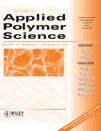Properties of a poly(L-lactic acid)/poly(D-lactic acid) stereocomplex and the stereocomplex crosslinked with triallyl isocyanurate by irradiation
Abstract
A poly(L-lactic acid) (PLLA)/poly(D-lactic acid) (PDLA) stereocomplex was prepared from an equimolar mixture of commercial-grade PLLA and PDLA by melt processing for the first time. Crosslinked samples were obtained by the radiation-induced crosslinking of the poly(lactic acid) (PLA) stereocomplex mixed with triallyl isocyanurate (TAIC). The PLA stereocomplex and its crosslinked samples were characterized by their gel behavior, thermal and mechanical measurements, and enzymatic degradation. The crosslinking density of the crosslinked stereocomplex was described as the gel fraction, which increased with the TAIC content and radiation dose. The maximum crosslinking density was obtained in crosslinked samples of PLA/3% TAIC and PLA/5% TAIC irradiated at doses higher than 30 kGy. The stable crosslinking networks that formed in the irradiated PLA/TAIC substantially suppressed the segmental mobility for the crystallization of single crystals as well as stereocomplex crystals. The crosslinking network also significantly improved the mechanical properties and inhibited the enzymatic degradation of crosslinked PLA/3% TAIC. © 2008 Wiley Periodicals, Inc. J Appl Polym Sci 2008




